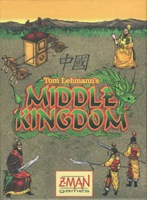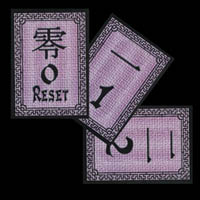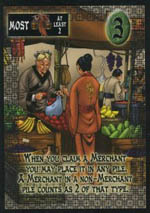by Dennis Hancock
 Middle Kingdom
Middle Kingdom
Published by Z-Man Games
Designed by Tom Lehmann
Artwork by Oliver Castaņeda
Layout by Paul Gerardi
Contents: 110 Cards, 18 Tokens, Rules
$15.00
So, What can you tell me about the Han Dynasty? Go ahead and look it up
on Wikipedia, I'll wait. Chances are, unless you are a history student
or have some particular interest in China, the answer is 'Nothing' or
maybe 'Not Much'. Thankfully, with Middle Kingdom, you don't need
knowledge of Chinese history. The Chinese theme is only a backdrop to
the game, and like many products, has negligible effect on the game
experience. Middle Kingdom is a non-collectible blind-bidding
style card game intended for 2-5 players of ages 12+. A full game of
five players should take approximately 40 minutes to play, with games of
fewer players taking less time. Now, with no bloodshed and 50% less MSG,
you too can claim the Emperor's throne for yourself.
The Contents
Inside each box you will find a 110-card deck, 18 cardboard punch out
victory tokens, and one small 8-page rulebook with a few full-color
illustrations. The card deck is made up of 6 goal cards, 40 bid cards,
62 dynasty cards, and 2 reference cards. The first thing I noted was
that the thickness and quality of the cardstock in the card deck seemed
a little thin. Unfortunately, since I don't own a micrometer, I can't
tell you if this is actually the case. All I can say is, they don't
stand up to some other games I have played. The victory tokens, on the
other hand, are what I would consider to be the baseline for the gaming
community. The tokens are made from somewhat thick cardstock that will
need to be punched out prior to use. They have a glossy finish and
should outlast the rest of the game pieces... assuming you don't lose them
first.
 The artwork is passable, if somewhat boring. All illustrations are full
color and somewhat cartoonish in appearance, but the artwork is
excessively repeated. The only truly unique illustrations in the deck
are on the six goal cards. All dynasty cards feature the same exact
background, with the only differences being the color in which they are
printed and the character represented. Each representing character on
the card looks exactly the same – there is no derivation in stance or
expression. For example, All 15 Merchant cards look exactly alike, with
the same guy carrying the same buckets of apples. It also would've been
helpful for the cards to have a name or description of what they
represent printed on them; instead there is just a picture. For example,
an empty throne represents the Heir card while the Merchant card is a
guy carrying two buckets of apples (doesn't that guy ever get tired?).
Everything is fine once you know what the cards represent, but beginners
to the game may find themselves scratching their heads. Ultimately, the
artwork doesn't much affect gameplay, but it's one example of how a
small change or some variety in artwork might have led to a more
enjoyable experience.
The artwork is passable, if somewhat boring. All illustrations are full
color and somewhat cartoonish in appearance, but the artwork is
excessively repeated. The only truly unique illustrations in the deck
are on the six goal cards. All dynasty cards feature the same exact
background, with the only differences being the color in which they are
printed and the character represented. Each representing character on
the card looks exactly the same – there is no derivation in stance or
expression. For example, All 15 Merchant cards look exactly alike, with
the same guy carrying the same buckets of apples. It also would've been
helpful for the cards to have a name or description of what they
represent printed on them; instead there is just a picture. For example,
an empty throne represents the Heir card while the Merchant card is a
guy carrying two buckets of apples (doesn't that guy ever get tired?).
Everything is fine once you know what the cards represent, but beginners
to the game may find themselves scratching their heads. Ultimately, the
artwork doesn't much affect gameplay, but it's one example of how a
small change or some variety in artwork might have led to a more
enjoyable experience.
The Rules
Normally I am a huge fan of small rulebooks; they generally mean that
the game is quick and easy to learn. With Middle Kingdom, this is
not necessarily the case. The game is easy enough to play, but the rules
are a little confusing to understand at first. The first issue I had
with the game was the objective. According to the overview, the game
ends when the Emperor dies and the player with the most points wins.
When does the Emperor die? Good question – there is nothing at all in
the rulebook or cards stating anything about the Emperor's death, with
the exception of one sentence. This frustrated my group of players, as
it was not clear when the game actually ended until later in the
rulebook. Buried on page six under the "Reveal Dynasty Cards" section,
the very last sentence states that the game ends when there are no
dynasty cards left to play. This sentence, which is easily missed,
should have been mentioned in the beginning of the rules.
The rulebook's examples of gameplay are also confusing. The first
example starts off by naming five players, what cards they have in their
possession, and what cards they are bidding with. There is so much
information being thrown at the reader, I would challenge any first time
player to be able to decipher who has what and which cards they are
playing without drawing out some sort of diagram. There are some
illustrations in the rulebook, but their only purpose is to name what
each of the cards in the deck represent, i.e. 'Merchant', 'Heir',
'Emperor', etc.
After actually playing through the game and looking back at the rules
again, the gameplay mostly makes sense. I did a little searching on
online and was glad to see I wasn't the only one who had questions –
there were a few folks complaining about some of the same issues I've
mentioned. Middle Kingdom would be much easier to learn to play
via game demo, rather than just reading the rulebook. After reading the
rules, my game group was frustrated and wanted to play something else. A
rulebook shouldn't do that.
The Gameplay
The game starts with each player having a deck of color-coded bid cards
numbering 0-7. At the start of the game a number of dynasty cards are
flipped face up on the table. The number of players determines the
number of dynasty cards, but in general, there is one less dynasty card
than the number of players in the game. Each player then secretly
selects a numbered bid card from their hand and all players flip them
face up on the table at the same time. The highest bidder chooses which
dynasty card they want, followed by the next highest bidder. If you are
wondering why somebody wouldn't automatically throw down their highest
card to claim a dynasty card, it's because if there is ever a tie, tied
players do not get any dynasty card for that round. Tied bids are
left on the table, and at the start of the next bidding phase new bids
are added to the previously tied total. Once a bid card has been used,
it is set aside and may not be used again until the owner plays their 0
card, which is also known as a reset card. Once the reset card has been
played, the owner may collect all of their spent bid cards and gets to
start over with a fresh bidding deck. I enjoyed the tactical aspect of
not bidding all of your high cards right off the bat and trying to
decide when to play the reset card.
After a player has collected two dynasty cards of the same type, they
may collect the goal card that associates with their dynasty cards. Each
goal card has a special rule printed on it that gives the owning player
an advantage over their competitors. The Emperor card, for example,
allows a player to add .5 to whichever bid card they play during the
bidding phase, with the apparent exception of the reset card. The rules
state that a reset card may not claim a dynasty card – however,
confusion arises when the owner of the Emperor card plays a reset card.
Does the 'Emperor' still add .5 to the 0 card? The rules seem to state
otherwise but it would be nice if there were a quick comment to clarify
this situation.
 If a player acquires more dynasty cards of a certain type than another
player, they may take the associated goal card away from that player. In
this way, goal cards may shift to different players over the course of a
game. Once all dynasty cards have been played from the draw deck,
the game is over (as per the difficult-to-find rule). All players total
up the number of victory points they have and subtract points based on
cards they are lacking. The player with the most points at the end of
the game is the winner.
If a player acquires more dynasty cards of a certain type than another
player, they may take the associated goal card away from that player. In
this way, goal cards may shift to different players over the course of a
game. Once all dynasty cards have been played from the draw deck,
the game is over (as per the difficult-to-find rule). All players total
up the number of victory points they have and subtract points based on
cards they are lacking. The player with the most points at the end of
the game is the winner.
During the course of the game, the Market goal card appeared to have
nearly game-breaking power. The Market allows a player to turn a claimed
Merchant card into any other type of dynasty card. If it were just
limited to that, this card might not be so powerful. Instead, merchants
converted in this manner count as two of any card they are converted to.
For Example: Player A has the Market card and sees that by converting a
single Merchant card to two Farmer cards, he can steal the Harvest goal
card from Player B. In order to steal it back, Player B will then have
to acquire two Farmer cards for every one Merchant card that player A
converts to a farmer. Of course, this is all assuming that we understood
the rules and were playing correctly. Please refer back to my previous
comment under 'The Game' section in regards to the confusing rules.
Two-player games and advanced three-player games run a bit different,
the rules for which are located in the rulebook.
Replayability
Even after the first game I can see the patterns starting to develop and
which goal cards are going to be more powerful than the others. I
foresee experienced players in the know, quickly snapping up the
powerful card combinations and 'pwning' the first time players. It
should quickly become obvious that strategic players will have a strong
advantage over more random players. Middle Kingdom is less
dependent on luck and may limit the replayability aspect as
non-strategic players will tire of repeatedly being beaten. I can maybe
see this game resurfacing for play a couple times a year at most.
Conclusion
If you are a fan of Tom Lehmann's games or blind bidding card games in
general, I might recommend this game to you. However, I don't see this
game becoming the new favorite of your game group. With rules
clarifications, some artwork revisions, and maybe some changes to the
rules on how the Market card is used, this could be a fun game to play.
You have to decide if this game is where you want your fifteen bucks to
go – I'll spend mine someplace else.
Ratings:
- Contents Rating: 2.5 out of 5 for thin cards, a lack of card identification on each card, and boring, repetitive artwork.
- Rules Rating: 2 out of 5 for the frustration the rules caused.
- Game Play Rating: 3 out of 5. It's entertaining for a while but nothing to write home about.
- Replayability Rating: 2.5 out of 5 due to repetitive artwork and winning goal card combos.
Overall Rating: 2.5 out of 5.
| Related reviews on OgreCave: |
|
|


 Middle Kingdom
Middle Kingdom The artwork is passable, if somewhat boring. All illustrations are full
color and somewhat cartoonish in appearance, but the artwork is
excessively repeated. The only truly unique illustrations in the deck
are on the six goal cards. All dynasty cards feature the same exact
background, with the only differences being the color in which they are
printed and the character represented. Each representing character on
the card looks exactly the same – there is no derivation in stance or
expression. For example, All 15 Merchant cards look exactly alike, with
the same guy carrying the same buckets of apples. It also would've been
helpful for the cards to have a name or description of what they
represent printed on them; instead there is just a picture. For example,
an empty throne represents the Heir card while the Merchant card is a
guy carrying two buckets of apples (doesn't that guy ever get tired?).
Everything is fine once you know what the cards represent, but beginners
to the game may find themselves scratching their heads. Ultimately, the
artwork doesn't much affect gameplay, but it's one example of how a
small change or some variety in artwork might have led to a more
enjoyable experience.
The artwork is passable, if somewhat boring. All illustrations are full
color and somewhat cartoonish in appearance, but the artwork is
excessively repeated. The only truly unique illustrations in the deck
are on the six goal cards. All dynasty cards feature the same exact
background, with the only differences being the color in which they are
printed and the character represented. Each representing character on
the card looks exactly the same – there is no derivation in stance or
expression. For example, All 15 Merchant cards look exactly alike, with
the same guy carrying the same buckets of apples. It also would've been
helpful for the cards to have a name or description of what they
represent printed on them; instead there is just a picture. For example,
an empty throne represents the Heir card while the Merchant card is a
guy carrying two buckets of apples (doesn't that guy ever get tired?).
Everything is fine once you know what the cards represent, but beginners
to the game may find themselves scratching their heads. Ultimately, the
artwork doesn't much affect gameplay, but it's one example of how a
small change or some variety in artwork might have led to a more
enjoyable experience.
 If a player acquires more dynasty cards of a certain type than another
player, they may take the associated goal card away from that player. In
this way, goal cards may shift to different players over the course of a
game. Once all dynasty cards have been played from the draw deck,
the game is over (as per the difficult-to-find rule). All players total
up the number of victory points they have and subtract points based on
cards they are lacking. The player with the most points at the end of
the game is the winner.
If a player acquires more dynasty cards of a certain type than another
player, they may take the associated goal card away from that player. In
this way, goal cards may shift to different players over the course of a
game. Once all dynasty cards have been played from the draw deck,
the game is over (as per the difficult-to-find rule). All players total
up the number of victory points they have and subtract points based on
cards they are lacking. The player with the most points at the end of
the game is the winner.